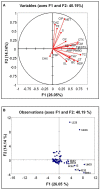Resistance to Antibiotics, Biocides, Preservatives and Metals in Bacteria Isolated from Seafoods: Co-Selection of Strains Resistant or Tolerant to Different Classes of Compounds
- PMID: 28912764
- PMCID: PMC5583239
- DOI: 10.3389/fmicb.2017.01650
Resistance to Antibiotics, Biocides, Preservatives and Metals in Bacteria Isolated from Seafoods: Co-Selection of Strains Resistant or Tolerant to Different Classes of Compounds
Abstract
Multi-drug resistant bacteria (particularly those producing extended-spectrum β-lactamases) have become a major health concern. The continued exposure to antibiotics, biocides, chemical preservatives, and metals in different settings such as the food chain or in the environment may result in development of multiple resistance or co-resistance. The aim of the present study was to determine multiple resistances (biocides, antibiotics, chemical preservatives, phenolic compounds, and metals) in bacterial isolates from seafoods. A 75.86% of the 87 isolates studied were resistant to at least one antibiotic or one biocide, and 6.90% were multiply resistant to at least three biocides and at least three antibiotics. Significant (P < 0.05) moderate or strong positive correlations were detected between tolerances to biocides, between antibiotics, and between antibiotics with biocides and other antimicrobials. A sub-set of 30 isolates selected according to antimicrobial resistance profile and food type were identified by 16S rDNA sequencing and tested for copper and zinc tolerance. Then, the genetic determinants for biocide and metal tolerance and antibiotic resistance were investigated. The selected isolates were identified as Pseudomonas (63.33%), Acinetobacter (13.33%), Aeromonas (13.33%), Shewanella, Proteus and Listeria (one isolate each). Antibiotic resistance determinants detected included sul1 (43.33% of tested isolates), sul2 (6.66%), blaTEM (16.66%), blaCTX-M (16.66%), blaPSE (10.00%), blaIMP (3.33%), blaNDM-1 (3.33%), floR (16.66%), aadA1 (20.0%), and aac(6')-Ib (16.66%). The only biocide resistance determinant detected among the selected isolates was qacEΔ1 (10.00%). A 23.30 of the selected isolates were able to grow on media containing 32 mM copper sulfate, and 46.60% on 8 mM zinc chloride. The metal resistance genes pcoA/copA, pcoR, and chrB were detected in 36.66, 6.66, and 13.33% of selected isolates, respectively. Twelve isolates tested positive for both metal and antibiotic resistance genes, including one isolate positive for the carbapenemase gene blaNDM-1 and for pcoA/copA. These results suggest that exposure to metals could co-select for antibiotic resistance and also highlight the potential of bacteria on seafoods to be involved in the transmission of antimicrobial resistance genes.
Keywords: antibiotics; antimicrobial resistance; biocides; metals; seafood.
Figures

Similar articles
-
Characterization of biocide-tolerant bacteria isolated from cheese and dairy small-medium enterprises.Food Microbiol. 2017 Apr;62:77-81. doi: 10.1016/j.fm.2016.10.008. Epub 2016 Oct 5. Food Microbiol. 2017. PMID: 27889169
-
Biocide Tolerance and Antibiotic Resistance in Salmonella Isolates from Hen Eggshells.Foodborne Pathog Dis. 2017 Feb;14(2):89-95. doi: 10.1089/fpd.2016.2182. Epub 2016 Nov 14. Foodborne Pathog Dis. 2017. PMID: 27841937
-
Biocide tolerance and antibiotic resistance of Enterobacter spp. isolated from an Algerian hospital environment.J Glob Antimicrob Resist. 2019 Sep;18:291-297. doi: 10.1016/j.jgar.2019.04.005. Epub 2019 Apr 18. J Glob Antimicrob Resist. 2019. PMID: 31005732
-
Co-Selection of Resistance to Antibiotics, Biocides and Heavy Metals, and Its Relevance to Foodborne Pathogens.Antibiotics (Basel). 2015 Nov 13;4(4):567-604. doi: 10.3390/antibiotics4040567. Antibiotics (Basel). 2015. PMID: 27025641 Free PMC article. Review.
-
Biocide tolerance in bacteria.Int J Food Microbiol. 2013 Mar 1;162(1):13-25. doi: 10.1016/j.ijfoodmicro.2012.12.028. Epub 2013 Jan 7. Int J Food Microbiol. 2013. PMID: 23340387 Review.
Cited by
-
Current Understanding of Potential Linkages between Biocide Tolerance and Antibiotic Cross-Resistance.Microorganisms. 2023 Aug 3;11(8):2000. doi: 10.3390/microorganisms11082000. Microorganisms. 2023. PMID: 37630560 Free PMC article. Review.
-
Insights into the Intersection of Biocide Resistance, Efflux Pumps, and Sequence Types in Carbapenem-Resistant Acinetobacter baumannii: A Multicenter Study.Pathogens. 2023 Jun 30;12(7):899. doi: 10.3390/pathogens12070899. Pathogens. 2023. PMID: 37513746 Free PMC article.
-
Antibiotic Resistance Genes and Bacterial Communities of Farmed Rainbow Trout Fillets (Oncorhynchus mykiss).Front Microbiol. 2020 Dec 3;11:590902. doi: 10.3389/fmicb.2020.590902. eCollection 2020. Front Microbiol. 2020. PMID: 33343530 Free PMC article.
-
Hygiene of Medical Devices and Minimum Inhibitory Concentrations for Alcohol-Based and QAC Disinfectants among Isolates from Physical Therapy Departments.Int J Environ Res Public Health. 2022 Nov 9;19(22):14690. doi: 10.3390/ijerph192214690. Int J Environ Res Public Health. 2022. PMID: 36429408 Free PMC article.
-
WHO Critical Priority Escherichia coli as One Health Challenge for a Post-Pandemic Scenario: Genomic Surveillance and Analysis of Current Trends in Brazil.Microbiol Spectr. 2022 Apr 27;10(2):e0125621. doi: 10.1128/spectrum.01256-21. Epub 2022 Mar 2. Microbiol Spectr. 2022. PMID: 35234515 Free PMC article.
References
-
- Badar U., Ahmed N., Shoeb E., Gadd G. M. (2014). Identification of the pco operon in Enterobacter species isolated from contaminated soil. Int. J. Adv. Res. 2, 227–233. 10.21474/IJAR01 - DOI
LinkOut - more resources
Full Text Sources
Other Literature Sources

